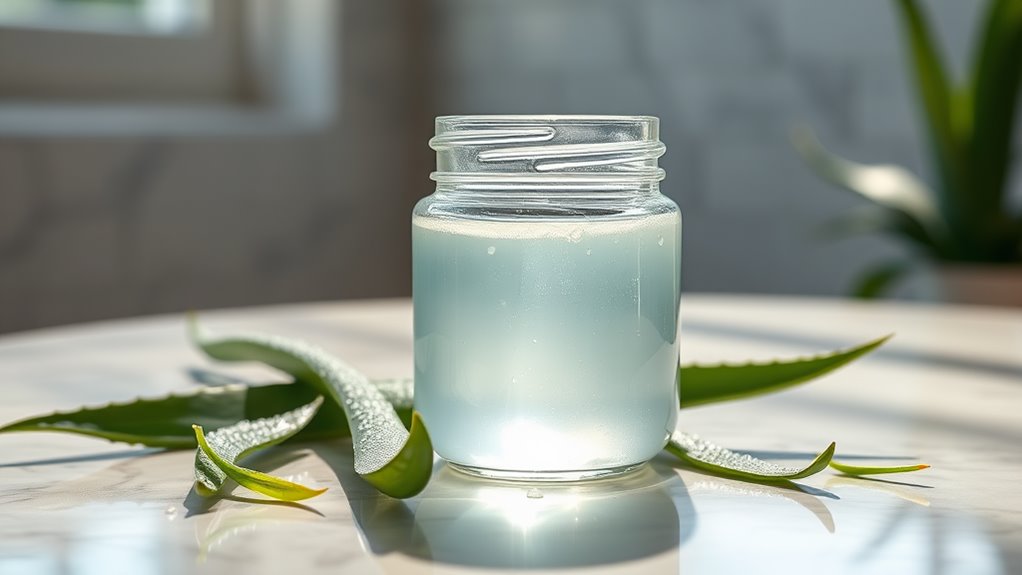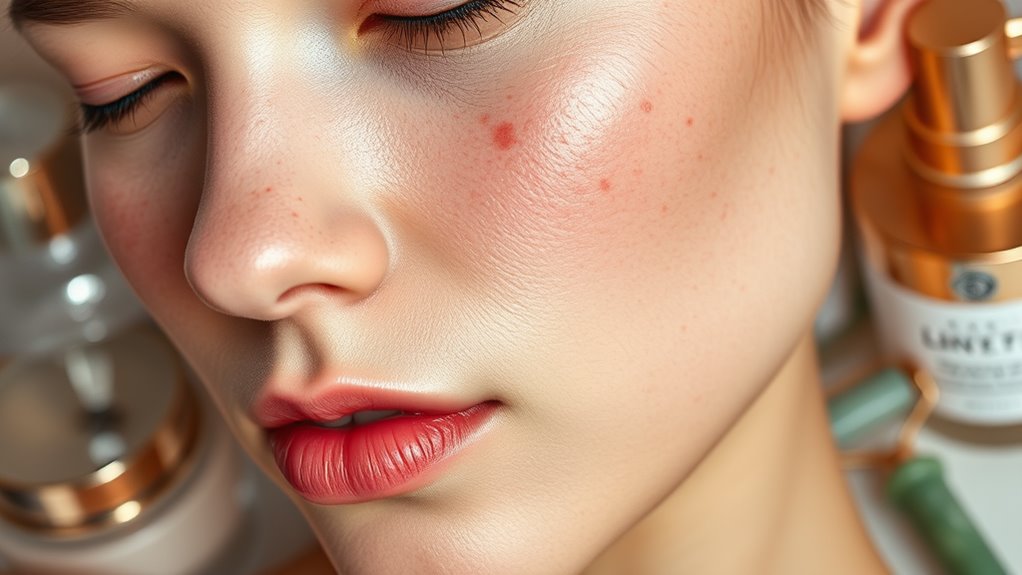This 1 Ingredient Is a Game-Changer for Acne-Prone Skin
Salicylic acid is a game-changer for acne-prone skin. This powerful beta hydroxy acid penetrates pores, dissolving excess oil and dead skin cells while calming inflammation. It effectively reduces redness and prevents future breakouts by promoting skin cell turnover and inhibiting acne-causing bacteria. Available in various forms, salicylic acid can be tailored to your skin type, ensuring gentle yet effective treatment. Discover how to integrate it into your routine and maximize its benefits for clearer skin.
Key Takeaways
- Salicylic acid penetrates deep into pores to dissolve excess oil and dead skin cells, effectively preventing acne formation.
- It possesses anti-inflammatory properties that reduce redness and swelling associated with active breakouts.
- The ingredient promotes skin cell turnover, improving overall skin texture and promoting a smoother complexion.
- Salicylic acid is available in various forms, making it adaptable for different skin types and sensitivities.
- Regular use, combined with sun protection, can lead to clearer skin within 4 to 12 weeks.
Understanding Acne-Prone Skin
Acne-prone skin is a complex condition characterized by the overproduction of sebum, clogged pores, and inflammation. To effectively manage this condition, you need to understand the underlying factors contributing to your skin’s vulnerabilities.
Hormonal fluctuations, dietary choices, and stress can exacerbate sebum production, leading to pore blockages. Incorporating salicylic acid for acne into your skincare routine can be particularly beneficial. This beta hydroxy acid penetrates deep into the pores, helping to dissolve excess oil and dead skin cells, thereby reducing the likelihood of breakouts. Additionally, salicylic acid possesses anti-inflammatory properties, which can help alleviate redness and swelling. Furthermore, it is known for its effectiveness as a game-changing ingredient in treating acne-prone skin.
What Is Salicylic Acid?
Salicylic acid, a beta hydroxy acid (BHA), is widely recognized for its powerful exfoliating properties and effectiveness in treating acne.
This organic compound, derived from willow bark, penetrates the skin’s surface, making it particularly beneficial for individuals with oily or acne-prone skin.
Salicylic acid works by dissolving the bonds between dead skin cells, promoting their shedding and preventing clogged pores. It also possesses anti-inflammatory properties, which can help reduce redness and swelling associated with acne lesions.
Additionally, its keratolytic action allows it to penetrate deep into the pores, targeting impurities and excess sebum.
For those seeking a reliable solution for acne management, salicylic acid is an essential ingredient to consider in your skincare regimen. Moreover, incorporating effective acne prevention tips can further enhance skin health and minimize breakouts.
How Salicylic Acid Works
When you apply salicylic acid to your skin, it effectively penetrates the upper layers to target clogged pores and excess oil. This active ingredient works through several mechanisms:
-
Exfoliation: It promotes the shedding of dead skin cells, preventing blockages in hair follicles.
-
Oil Regulation: Salicylic acid reduces sebum production, which diminishes the likelihood of pore congestion.
-
Anti-inflammatory Action: It helps calm redness and swelling associated with acne lesions.
-
Antimicrobial Properties: The acid inhibits the growth of acne-causing bacteria, further reducing breakouts. Additionally, addressing underlying dietary choices can further enhance the effectiveness of salicylic acid in managing acne.
Benefits of Salicylic Acid for Acne
One of the most significant benefits of salicylic acid for acne treatment is its ability to deeply cleanse pores and prevent future breakouts.
By exfoliating the skin’s surface and penetrating the follicle, salicylic acid effectively dissolves excess sebum and debris, minimizing clogged pores that lead to acne formation.
Additionally, it possesses anti-inflammatory properties that reduce redness and swelling associated with active breakouts.
Regular use can also enhance skin texture, promoting a smoother, more even complexion.
Importantly, salicylic acid helps regulate skin cell turnover, ensuring that dead skin cells are efficiently shed.
This multifaceted approach not only treats existing acne but also proactively prevents new blemishes, making it an essential ingredient in your skincare regimen for acne-prone skin. Moreover, using salicylic acid can help address the common acne skincare mistake of neglecting proper exfoliation, which is crucial for maintaining clear skin.
Different Forms of Salicylic Acid
Various forms of salicylic acid are available, each offering unique benefits for acne treatment. Understanding these forms can enhance your skincare regimen.
Here are four common types:
-
Liquid: Often used in toners, it penetrates pores effectively, making it great for oily skin.
-
Gel: Provides a thicker consistency, ideal for targeted application on blemishes.
-
Cream: Suitable for sensitive skin, it hydrates while delivering the acne-fighting properties of salicylic acid.
-
Exfoliating Pads: Pre-soaked with salicylic acid, these pads simplify exfoliation and can easily be integrated into your routine.
Choosing the right form can maximize your treatment outcomes and improve skin clarity, so consider your skin type and concerns when selecting a product. Additionally, using the appropriate cleanser for your skin type can further enhance the effectiveness of the salicylic acid in your routine.
Choosing the Right Salicylic Acid Product
Selecting the right salicylic acid product can significantly impact your acne treatment results. When evaluating options, consider the concentration, formulation type, and additional ingredients that complement salicylic acid.
| Feature | Considerations | Best Options |
|---|---|---|
| Concentration | 0.5% for mild acne; 2% for severe | 1% and 2% formulations |
| Formulation Type | Gel, lotion, or spot treatment | Lightweight gel |
| Additional Ingredients | Look for soothing agents like aloe | Products with niacinamide |
Choose products that suit your skin type and address specific concerns. Higher concentrations can deliver faster results but may irritate sensitive skin. Always patch-test new products to ensure compatibility.
How to Incorporate Salicylic Acid Into Your Routine
Incorporating salicylic acid into your skincare routine can significantly enhance your acne treatment effectiveness when done correctly.
Follow these steps to master its use:
-
Start Slowly: Begin with a low concentration (0.5% to 2%) to assess your skin’s tolerance.
-
Patch Test: Apply a small amount on a discreet area to check for adverse reactions.
-
Timing: Use salicylic acid in your evening routine after cleansing, allowing it to work overnight.
-
Moisturize: Follow up with a non-comedogenic moisturizer to prevent dryness.
Common Mistakes to Avoid
When managing acne-prone skin, you might unknowingly make some critical mistakes.
Overusing products, neglecting patch tests, and skipping sun protection can hinder your progress and exacerbate issues.
It’s essential to recognize these pitfalls to optimize your skincare routine effectively.
Overusing Products
Although you might think that layering multiple products will yield faster results, overusing skincare products can actually lead to irritation and exacerbate acne-prone skin.
It’s essential to refine your routine to avoid common pitfalls. Consider these key points:
-
Limit Active Ingredients: Using too many active compounds can overwhelm your skin, leading to sensitivity.
-
Check Concentrations: Higher concentrations of ingredients don’t always mean better results; more can be detrimental.
-
Avoid Frequent Switching: Constantly changing products can disrupt your skin’s natural barrier.
-
Adhere to Recommended Usage: Follow guidelines for each product; over-application won’t speed up healing.
Ignoring Patch Tests
Layering multiple products without caution can lead to adverse reactions, making it vital to assess how your skin responds to new ingredients.
Ignoring patch tests is a common mistake that can exacerbate existing skin issues. A patch test involves applying a small amount of the new product to a discreet area of your skin, typically behind the ear or on your inner forearm.
Wait 24 to 48 hours to monitor for any signs of irritation, redness, or allergic reactions. This simple step can save you from severe breakouts or inflammation, particularly when dealing with acne-prone skin.
Skipping Sun Protection
Many people underestimate the importance of sun protection, believing that it’s unnecessary for acne-prone skin.
However, neglecting this crucial step can exacerbate your condition. Here’s why you shouldn’t skip it:
-
UV Damage: Sun exposure can worsen inflammation and promote post-inflammatory hyperpigmentation, leading to darker scars.
-
Skin Barrier Disruption: UV rays can compromise your skin barrier, increasing acne breakouts due to heightened sensitivity.
-
Increased Oil Production: Sun damage may stimulate overproduction of sebum, contributing to clogged pores.
-
Healing Impairment: Sun exposure can hinder the healing process of existing acne lesions, prolonging your skin’s recovery time.
Incorporating effective sun protection into your routine is essential for achieving clearer, healthier skin.
Don’t underestimate its role in your acne management strategy.
Combining Salicylic Acid With Other Ingredients
When combining salicylic acid with other ingredients, it’s crucial to choose pairings that enhance its efficacy without causing irritation.
Avoid harsh combinations that can compromise your skin barrier, and explore effective layering techniques to maximize benefits.
Understanding these principles will help you achieve clearer, healthier skin.
Best Pairings for Efficacy
Combining salicylic acid with other ingredients can significantly enhance its effectiveness in treating acne-prone skin.
Here are four optimal pairings:
-
Benzoyl Peroxide: This powerful antibacterial ingredient targets acne-causing bacteria, complementing salicylic acid’s exfoliating properties.
-
Niacinamide: Known for its anti-inflammatory effects, niacinamide reduces redness and irritation, promoting a more even skin tone.
-
Hyaluronic Acid: This hydrating powerhouse offsets salicylic acid’s drying effects, ensuring your skin remains moisturized without clogging pores.
-
Lactic Acid: As an alpha hydroxy acid, lactic acid further exfoliates and promotes cell turnover, enhancing salicylic acid’s acne-fighting capabilities.
Incorporating these combinations can lead to clearer, healthier skin while maximizing the benefits of salicylic acid.
Avoiding Harsh Combinations
While salicylic acid is a potent ally against acne, pairing it with certain ingredients can lead to irritation or diminished effectiveness.
Combining it with other exfoliants, such as glycolic acid or certain retinoids, can overwhelm your skin, increasing the risk of redness and peeling. Additionally, mixing salicylic acid with strong astringents, like alcohol-based toners, can strip your skin’s natural barrier, exacerbating dryness and sensitivity.
It’s crucial to avoid these harsh combinations to maintain your skin’s health. Instead, consider using salicylic acid on its own or alongside gentle, hydrating ingredients like hyaluronic acid.
This approach will ensure you maximize its acne-fighting potential without compromising your skin’s integrity. Prioritize understanding your skin’s response to achieve optimal results.
Layering Techniques Explained
Understanding how to layer salicylic acid with other ingredients can enhance your skincare routine and maximize its acne-fighting benefits.
Here are four effective layering techniques:
-
Cleanser First: Start with a salicylic acid cleanser to unclog pores and prep your skin.
-
Toner Application: Follow with a gentle, alcohol-free toner to balance pH and further cleanse.
-
Serum Integration: Use a lightweight, hydrating serum containing niacinamide to combat inflammation and support moisture.
-
Moisturizer Seal: Finish with a non-comedogenic moisturizer to lock in hydration without clogging pores.
Expected Results and Timeline
As you embark on your journey to clearer skin, it’s essential to set realistic expectations regarding the results and timeline of your acne treatment. Typically, initial improvements may appear within 4 to 6 weeks, while more significant changes often take 8 to 12 weeks. Consistency is key.
| Timeframe | Expected Results |
|---|---|
| 0-4 Weeks | Initial reduction in inflammation |
| 4-8 Weeks | Noticeable decrease in breakouts |
| 8-12 Weeks | Marked improvement in skin texture |
Patience and adherence to your regimen can accelerate these results. Remember, everyone’s skin responds differently, so monitor your progress and adjust your approach as needed for optimal outcomes.
Potential Side Effects
When using new acne treatments, you might experience common skin reactions such as dryness or irritation.
It’s also crucial to be aware of potential allergic responses, which can vary in severity.
Additionally, consider the long-term effects of continued use, as they may influence your skin’s overall health.
Common Skin Reactions
Although many treatments for acne-prone skin promise clear results, they can also lead to common skin reactions that users should be aware of.
Understanding these reactions is crucial for effective management of your skin.
-
Redness: Increased blood flow can cause localized redness, indicating irritation.
-
Dryness: Over-exfoliation or harsh ingredients may strip your skin of essential moisture, leading to dryness.
-
Peeling: This often results from the skin’s natural response to aggressive treatments, revealing new skin layers.
-
Sensitivity: Heightened sensitivity may occur, making your skin more reactive to other products or environmental factors.
Allergic Responses Explained
While many treatments for acne are designed to improve your skin, they can also trigger allergic responses that may complicate your skincare journey.
Allergic reactions can manifest as redness, swelling, itching, or hives, indicating your skin’s hypersensitivity to specific ingredients. Common culprits include fragrances, preservatives, and certain active compounds.
If you notice these symptoms after introducing a new product, it’s crucial to discontinue use immediately and consult a dermatologist. They can help identify the offending ingredient through patch testing.
Understanding your skin’s unique sensitivities allows you to choose products that enhance your routine without adverse effects.
Always perform a patch test before incorporating new treatments to minimize potential allergic reactions and safeguard your skin’s health.
Long-Term Use Effects
Using acne treatments over an extended period can lead to a variety of potential side effects that you should be aware of.
Long-term application may result in:
-
Skin Irritation: Persistent use can lead to redness, dryness, or peeling.
-
Sensitivity: Your skin may become more sensitive to environmental factors, such as UV exposure.
-
Tolerance: Over time, your skin might build a tolerance, reducing the treatment’s effectiveness.
-
Microbial Resistance: Prolonged use can potentially lead to an imbalance in skin microbiota, allowing harmful bacteria to thrive.
It’s crucial to monitor your skin’s response and consult a dermatologist if you experience any adverse effects.
Adjusting your treatment plan might be necessary to maintain optimal skin health.
Maintaining Clear Skin Long-Term
To maintain clear skin long-term, it’s essential to adopt a consistent skincare routine that addresses your specific needs.
Start by cleansing twice daily with a gentle, non-comedogenic cleanser to remove excess oil and impurities. Incorporate a targeted treatment containing your game-changing ingredient, which will help regulate sebum production and prevent breakouts.
Don’t forget to exfoliate regularly, as this removes dead skin cells that can clog pores. Hydration is crucial; use a lightweight, oil-free moisturizer to keep your skin balanced.
Additionally, apply broad-spectrum sunscreen daily to protect against UV damage, which can exacerbate acne.
Monitor your skin’s response and adjust your routine as necessary, ensuring you maintain optimal skin health over time. Consistency is key for lasting results.




